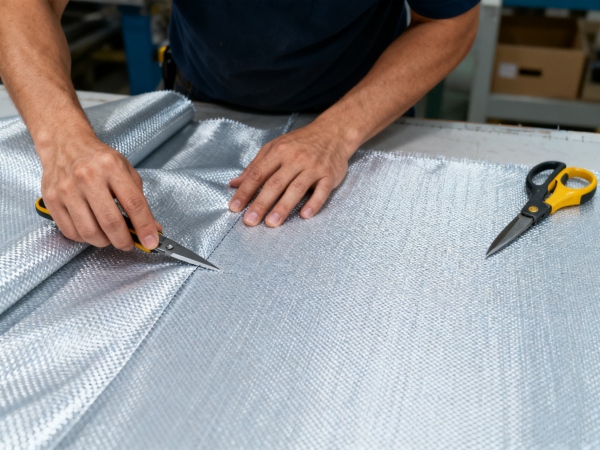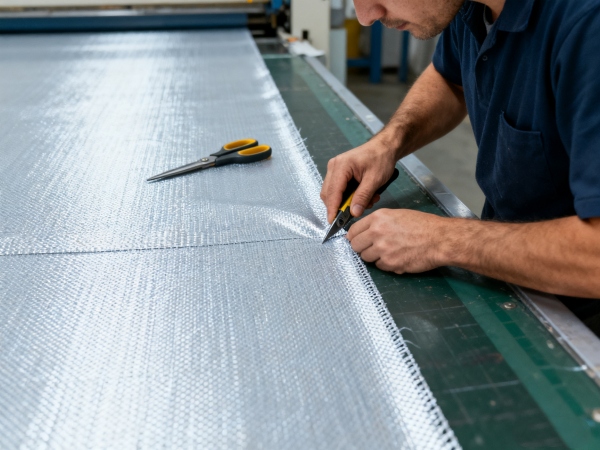Fiberglass reinforced plastic (FRP) is a versatile material widely used in construction, automotive, and industrial applications. With years of hands-on experience working with fiberglass fabrics and FRP panels, I’ve seen how improper cutting can lead to wasted material, rough edges, and even personal injury.
This guide shares practical, easy-to-follow methods for cutting FRP efficiently, safely, and cleanly.

Cutting FRP requires tools that balance precision with durability. Based on my experience, these are the most reliable options for beginners and professionals alike:
Hand Saws: Fine-toothed hacksaws or fiberglass saws are ideal for small sheets or minor adjustments. They provide control and reduce the risk of cracking.
Power Tools: Circular saws, jigsaws, and angle grinders fitted with carbide or diamond-tipped blades make cutting thicker FRP panels faster. Always choose a blade rated for fiberglass to avoid splintering.
Cutting Supports: Secure the FRP sheet on a stable workbench with clamps to prevent movement. This ensures straight cuts and safety.
Safety Gear: A respirator mask, safety goggles, and gloves are essential. Fiberglass dust can irritate skin, eyes, and lungs. Experience has taught me that protective gear is non-negotiable.
Precision and patience are key when cutting FRP. Follow these steps to achieve smooth, accurate results:
1. Measure and Mark: Use a fine-tip marker or pencil to outline the cut. Double-check measurements to avoid mistakes.
2. Secure the Sheet: Clamp the FRP sheet firmly to prevent vibrations or slipping during cutting.
3. Choose the Right Tool: Select a hand saw for small cuts or a power tool for larger or thicker sheets.
4. Cut Slowly and Steadily: Apply consistent pressure and let the blade do the work. Rushing can cause chipping or uneven edges.
5. Support Both Sides: Keep one side supported to prevent the sheet from bending or breaking mid-cut.
Achieving a clean, straight edge requires attention to detail:
Score Before Cutting: Lightly scoring along the cutting line with a utility knife can help guide the saw and prevent splintering.
Use Painter’s Tape: Applying tape along the cut line reduces fraying and chipping, especially with circular saws.
Slow and Even Motion: Avoid jerky movements. Smooth, controlled cuts produce the best edges.
Blade Choice Matters: Fine-toothed or carbide-tipped blades produce smoother results than standard blades.

Chipping and splintering are common issues, especially with thin or layered FRP panels. Strategies to minimize these include:
1. Cut from the Correct Side: When using a circular saw, cut with the finished side facing down to reduce visible chipping.
2. Support the Cut Line: Place scrap wood underneath the sheet where you plan to cut. This provides support and reduces vibrations.
3. Multiple Passes: For thick sheets, make shallow cuts in multiple passes instead of trying to cut through in one go.
4. Proper Blade Speed: Adjust saw speed to match the thickness and density of the FRP. Too fast can cause tearing; too slow can overheat the blade.
From years of experience, the following mistakes are the most frequent among beginners:
Skipping Safety Gear: Fiberglass dust is not just messy—it can be hazardous. Always wear protection.
Using the Wrong Blade: Standard wood blades can tear FRP fibers, resulting in rough edges.
Ignoring Support: Unsecured sheets can bend or snap, leading to waste or injury.
Rushing the Cut: Hasty cuts compromise precision and safety. Patience ensures cleaner results.
Not Cleaning After Cutting: Fiberglass dust should be vacuumed or wiped down to prevent skin irritation or respiratory issues.